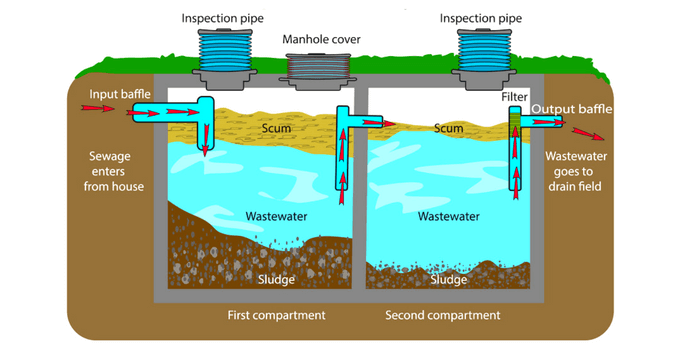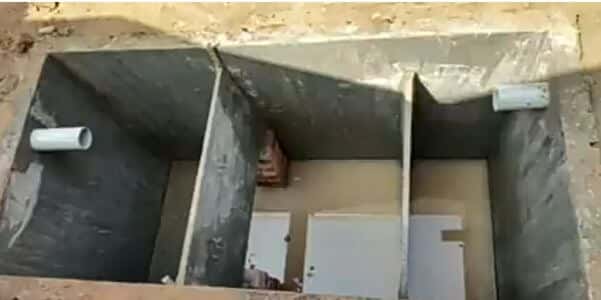Table of Contents
What Is A Septic Tank?
It is a beneath-the-ground or underground structure that helps in wastewater treatment by allowing biological decomposition and drainage. In rural areas without centralized sewer systems, this is a common practice.
A septic tank treats wastewater from house plumbing such as washrooms, laundry, and kitchen drains using natural techniques and proven methods.
Septic tank system design is relatively simple. It is a watertight underground container, usually rectangular or round, constructed of concrete, plastic, or fiberglass. It is a kind of onsite sewage facility providing primary treatment only.
It allows the safe treatment of wastewater for homes with poor drainage or not connected to the leading sewage network.
They function by accumulating excreta and wastewater in an underground tank. Generally, they are found in rural areas.
How does a Septic Tank work?

A septic tank helps to digest unprocessed material while separating floatable material (such as oils and grease) and solids from wastewater.
- Waste Water runs from your kitchen, toilet, etc., via one primary drainage pipe to your septic tank.
- The underground tank begins storing the wastewater and maintaining it for a long time, so the solid waste settles down and oil and grease float.
- Now liquid wastewater (effluent) leaves the tank and runs into the soil absorption field.
- This wastewater is released through pipes onto absorbent surfaces, which permit wastewater to filter via the soil.
- The soil receives, treats, and spreads wastewater as it percolates through it, finally released into groundwater.
- Ultimately, the wastewater percolates into the soil, naturally removing nutrients, viruses, and harmful coliform bacteria.
Septic Tank Details
A standard septic system contains a tank and soil absorption fields or drain fields. It has two chambers or boxes, and one tank gets wastewater via an inlet pipe. Commonly, they are seated belowground, 50 meters out from the house.
Septic tank chambers and a T-shaped outlet stop sludge and scum from escaping the tank and getting into the drain field area.
Two pipes will connect a septic tank (for the inlet and outlet). The inlet pipe carries wastewater from the house to the tank. It is retained here for a long time to isolate the waste into liquid and solid forms.
An outlet pipe, also known as the drain field, carries pre-treated wastewater from the septic tank and distributes it equally throughout the soil and drainage channels.
The wastewater eventually separates into three layers. (As shown in the image above.)

The top layer contains oil and grease and floats above the waste. It is generally known as “scum.”
The mid-layer has waste and waste particles.
The final and bottom layers have bulkier particles than water and make a sludge layer.
Bacteria within the tank work hard to break down the solid waste, enabling fluids to isolate and drain.
As part of routine maintenance, whatever is left at the bottom of the tank must be routinely removed. It is among the factors that make it a simple type of sewage treatment.
In a soil-based system, the septic tank releases the liquid or effluent into a sequence of drilled pipes concealed in drain fields, chambers, or other specialized units made for gradually discharging the liquid into the soil.
Pumps or gravity are used in alternative systems to help septic tank effluent slow drip via sand, organic matter (e.g., peat and sawdust), wetlands, or other media to eliminate or neutralize contaminants such as illness pathogens, nitrogen, phosphorus, and other pollutants.
Some other systems are invented to evaporate or disinfect wastewater before discharging it into the soil.
Types of Septic Tank
They are constructed of various materials with varying degrees of durability and strength. Based on the material used for construction, the following are the different types of septic tanks.
Concrete Septic Tank
These long-lasting tanks can typically last several decades. But, if the concrete cracks, these tanks can enable waste to leak out and groundwater to enter. The blockage may affect water outflow when backups occur in this tank.
Steel Septic Tank
Even though steel is a material with high inherent durability, steel septic tanks typically only last 25 years before they start to rust; therefore less frequently chosen by homeowners.
A steel tank’s ability to withstand the weight of the land above it may become compromised if rust develops on the tank’s roof. If this happens, a human or animal may fall into the tank.
If the rest of the steel tank is structurally sound, you can change the cover to save money. Property owners need to look for rust development on entry and exit baffles.
Fiberglass Septic Tank
Fiberglass, unlike concrete or steel, does not crack or rust. Because fiberglass tanks are lighter than other tanks, they are simpler to install but more likely to move when the nearby soil becomes overloaded.
Plastic Septic Tank
Plastic tanks are long-lasting, lightweight, and cost-effective. These septic tanks will not rust and are less probable to crack than concrete. These tanks are lightweight, making them simple to install.
Because they are so light, they are susceptible to damage during installation. Furthermore, if plastic tanks are not installed properly, they can float to the surface.
Aerobic Septic Tank
When other tanks on a site fail, these electricity-powered tanks are frequently put in place.
These tanks are up to three times costlier than other septic tanks but more efficient and need fewer drain fields, which may be advantageous for smaller homes.
Although these tanks need more frequent service, they typically last for many years.
Final Words
Septic tanks are not necessary for those who live in cities or towns because wastewater is transported and treated by their sewage system. A local management company manages and maintains it.
A septic system enables any residence to use its water facilities. However, some additional precautionary measures need to follow. Regular septic tank maintenance is also necessary.
Homeowners having a septic tank have an extra duty to ensure that their tank doesn’t contaminate the regional environment.
For example, if the drain field becomes overfilled with liquid, it may flood, pushing untreated wastewater to flow to the surface of the ground or causing blockages in the sink and toilets.
Thanks!
Also, Read
What are the common Impurities In Water?
Plumbing Traps – Purpose, 15 Types of Plumbing Traps
16 Types of Pipe Fittings In Plumbing Systems
Building Construction Process Step By Step